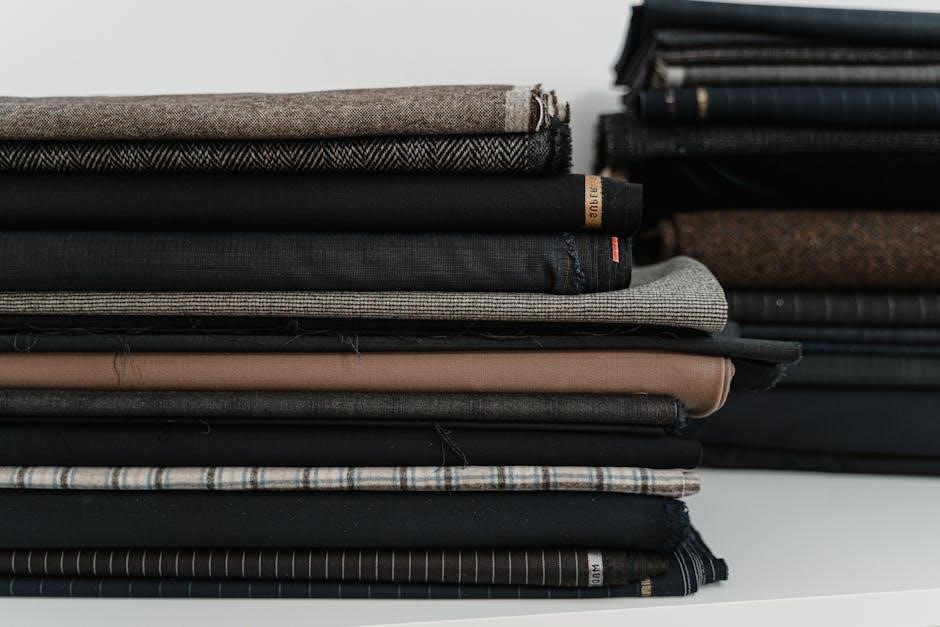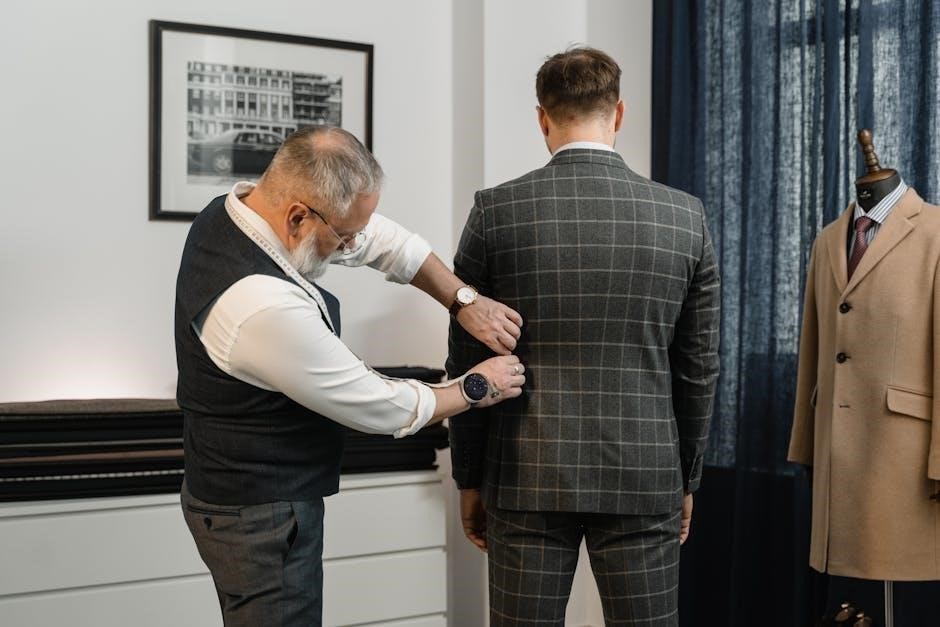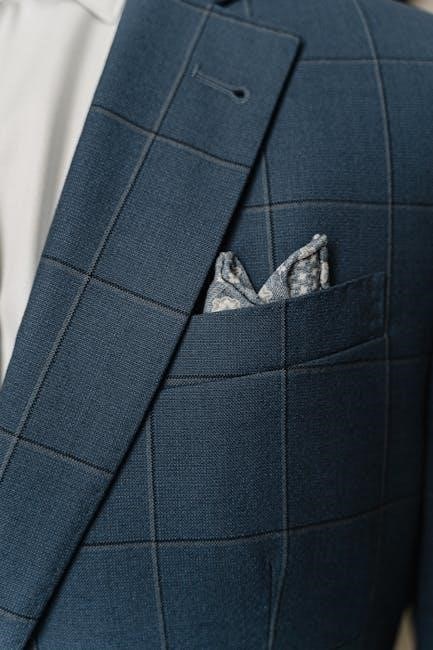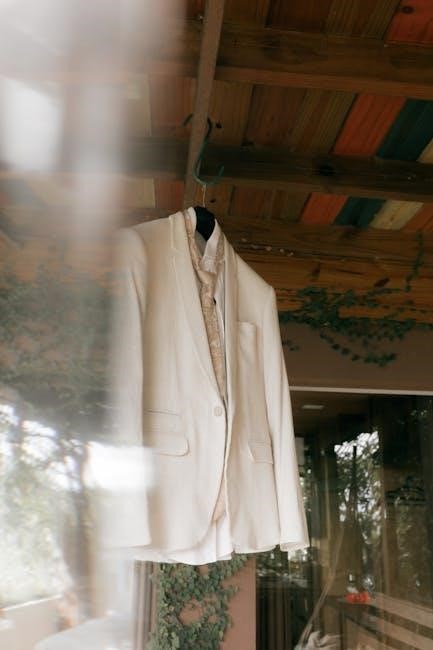Accurate suit jacket measurements are essential for a perfect fit, ensuring confidence and style. Key measurements include chest, shoulders, and sleeve length, with proper fit enhancing both appearance and comfort. A well-tailored jacket moves naturally with your body.

Understanding Key Measurements
Key measurements for a suit jacket include chest, shoulders, sleeve length, natural waist, and hips. These measurements ensure a tailored fit, with chest size determining jacket size and shoulders defining the garment’s structure and drape.
2.1 Chest Measurement
The chest measurement is the foundation of determining your jacket size. To measure accurately, wrap a tape measure around the fullest part of your chest, typically just under your armpits. Ensure the tape is level and snug but not tight—you should be able to slide a finger underneath; Breathe naturally during this process; holding your breath or puffing out your chest can lead to an overestimated size. This measurement is crucial as it sets the base for other calculations, such as the jacket’s drop and fit type. For slim-fit jackets, the chest measurement is used with minimal added ease, while regular or relaxed fits incorporate more room for comfort. Accurate chest measurement ensures the jacket drapes correctly, allowing for a full range of motion and a polished appearance. Always measure over a dress shirt to account for layering, as this will affect the final fit of the jacket.
2.2 Shoulder Measurement
The shoulder measurement is one of the most critical dimensions for a well-fitted jacket, as it determines how the garment hangs and defines your silhouette. To measure accurately, stand upright and place the tape measure across the back, from the edge of one shoulder (where your arm meets your torso) to the edge of the other. Keep the tape straight and level, ensuring it follows the natural line of your shoulders. This measurement is vital because altering shoulder fit is both challenging and costly. A properly fitted jacket should have shoulders that align perfectly with your natural shoulder points—neither extending beyond them nor falling short. When the shoulders fit correctly, the jacket drapes smoothly, eliminating any pulling or bunching in the fabric. This ensures a sharp, tailored appearance that enhances your overall look. For the most accurate results, consider having someone assist you with this measurement, as self-measuring can be less precise. A well-measured shoulder ensures the jacket sits naturally, creating a balanced and polished look.
2.3 Sleeve Length Measurement
Sleeve length is a crucial measurement for ensuring a polished and professional look in a suit jacket. To measure accurately, start from the shoulder point (where your arm meets your torso) and run the tape measure down the arm to the desired cuff length. The standard recommendation is to have about a quarter to a half-inch of shirt cuff visible beyond the jacket sleeve for a balanced appearance. This ensures the jacket sleeves are neither too long nor too short, which can disrupt the overall proportions of the garment. Keep your arm relaxed by your side during the measurement to avoid any distortion. Some individuals prefer slightly shorter sleeves for a modern aesthetic, while others opt for traditional lengths. Proper sleeve length ensures comfort and mobility, allowing for a full range of motion without restricting the arm. Accurate sleeve measurements are essential for a tailored fit, as they directly impact the jacket’s functionality and style. Ensuring the sleeves are well-proportioned enhances the overall fit and creates a sharp, put-together look.
2.4 Natural Waist Measurement
The natural waist measurement is a critical factor in achieving a well-fitted suit jacket. It is typically taken at the narrowest part of your torso, usually about an inch above your navel. To measure accurately, stand upright and wrap the tape measure around your natural waistline, ensuring it is level and snug but not tight. This measurement helps determine how much the jacket should be tailored to create a streamlined silhouette. It is important to measure naturally without sucking in your stomach, as this will ensure the jacket fits comfortably and allows for proper movement. The natural waist measurement is essential for defining the jacket’s shape and ensuring it complements your body type. Accurate measurements here prevent issues like a too-tight or too-loose fit, which can affect both comfort and appearance. By taking the time to measure your natural waist correctly, you can ensure your suit jacket looks sharp and feels great. This measurement is a cornerstone of achieving a tailored, professional look.
2.5 Hip Measurement
The hip measurement is another important aspect of ensuring a well-fitted suit jacket. It is typically taken around the fullest part of your hips and seat, usually about 7-9 inches below your natural waistline. To measure accurately, stand with your feet together and wrap the tape measure around the widest part of your hips, keeping it level and parallel to the floor. This measurement is crucial for determining the fit of the jacket’s lower section, particularly if you prefer a more tailored or relaxed style. A precise hip measurement ensures that the jacket sits comfortably and maintains a balanced proportion with the rest of the garment. It also helps prevent issues such as pulling or excess fabric, which can detract from the overall appearance. By ensuring your hip measurement is accurate, you can achieve a jacket that complements your body shape and provides a polished, professional look. This measurement, combined with others, contributes to a jacket that not only fits well but also enhances your natural silhouette.

Fit Types
Slim Fit: Closer to the body, ideal for a modern look. Regular Fit: Classic style with moderate shaping. Relaxed Fit: Roomier, offering comfort and a looser silhouette. Each fit type caters to different body types and personal preferences, ensuring a tailored appearance.
3.1 Slim Fit
A slim fit jacket is designed to hug the body closely, creating a modern and streamlined appearance. It is particularly popular among younger professionals and those with athletic builds, as it accentuates a lean physique. To achieve this fit, measurements are taken with minimal room for excess fabric, ensuring a sharp, tailored look. The chest, shoulder, and sleeve measurements are tailored almost exactly to your body, allowing for ease of movement while maintaining a sleek silhouette. The sleeve length is typically shorter, and the jacket length is slightly shorter than traditional fits, creating a balanced proportion. For a slim fit, it’s crucial to ensure precise measurements, as there is little room for error. Styling tips include pairing the jacket with slim-fit pants and ensuring shirt cuffs are slightly visible to complete the polished look. This fit type is ideal for those who want a contemporary, fashion-forward aesthetic while maintaining professionalism.
3.2 Regular Fit
A regular fit jacket offers a classic, timeless style that balances comfort and tailoring. It is designed with moderate shaping, providing a slightly looser fit than slim-fit jackets while still maintaining a polished appearance. This fit type is ideal for most body types and professional settings, as it offers ease of movement and a traditional aesthetic. The regular fit is characterized by a slightly roomier chest and shoulder area compared to slim-fit jackets, making it a versatile choice for everyday wear. It is particularly suitable for those who prefer a comfortable fit without sacrificing style. The jacket length and sleeve measurements are proportionate to the body, ensuring a balanced look. Styling tips for a regular fit include pairing it with tailored trousers or chinos for a sharp, professional appearance. This fit is also versatile enough to be dressed down with jeans for a more casual look. Overall, the regular fit is a reliable choice for anyone seeking a classic, well-fitted jacket that works in various settings.
3.3 Relaxed Fit
A relaxed fit jacket is designed for comfort and ease, offering a roomier silhouette through the chest and waist. This fit type is ideal for individuals with larger body types or those who prioritize comfort over a tailored look. The relaxed fit provides ample space in the chest and shoulders, ensuring freedom of movement while maintaining a stylish appearance. It is less structured compared to slim or regular fits, making it a great choice for casual or professional settings where comfort is key. The jacket length and sleeve measurements are proportionate to the body, ensuring a balanced look. For styling, pairing the jacket with well-fitted pants or chinos can create a sharp, polished appearance. The relaxed fit is perfect for those who want a comfortable yet stylish option without sacrificing the sophistication of a suit jacket. It is also a practical choice for individuals who prefer a looser fit for everyday wear or specific body types that require more room. This fit ensures a comfortable and confident look in any setting.

Measuring for Jacket Length
Measuring for jacket length is crucial to ensure a balanced and proportionate fit. To determine the ideal length, start by standing upright and placing the tape measure at the base of your collar, directly at the back of your neck. From this point, run the tape measure straight down your spine to the desired endpoint of the jacket. The standard length should cover your seat but not extend much beyond it, as this ensures a streamlined appearance. For taller individuals, slightly longer jackets can be worn to maintain harmony with their height, while shorter men should opt for shorter lengths to avoid being overwhelmed by excess fabric. The jacket should hit just below the hip bone for most body types, creating a balanced silhouette. Proper jacket length enhances overall proportions and complements your body type, ensuring a sharp and polished look. This measurement is essential for achieving a tailored fit that flatters your frame and allows for ease of movement.

Measuring for Jacket Waist
Measuring for jacket waist is a critical step in achieving a tailored fit. To accurately determine your waist measurement, locate your natural waistline, which is typically the narrowest part of your torso, about an inch above your navel. Wrap a flexible tape measure around this area, ensuring it is snug but not tight—you should be able to slide a finger underneath comfortably. The tape should be parallel to the floor and level all the way around your body. This measurement is essential for determining how much the jacket needs to be tailored to create a streamlined silhouette. For a more precise fit, avoid sucking in your stomach or holding your breath, as this can lead to inaccurate results. The jacket waist measurement ensures the garment sits comfortably and looks sharp, whether you’re wearing it for a formal event or a professional setting. Properly measuring your waist helps in achieving a balance between style and comfort, making your suit look effortlessly tailored.

Common Mistakes to Avoid
When measuring for a suit jacket, several common mistakes can lead to an ill-fitting garment. One of the most frequent errors is not wearing a dress shirt during measurements, as this can result in a jacket that is too tight or too loose. Another mistake is holding your breath or tensing up while measuring the chest, which can cause inaccurate results. Additionally, many people incorrectly measure the shoulders by slouching or rounding them, leading to poor shoulder fit. Sleeve length is also often mismeasured, with some individuals failing to account for the desired shirt cuff exposure. A common oversight is not having someone assist with the measurements, as self-measuring can be less precise. Lastly, ignoring the natural waistline measurement can result in a jacket that does not sit properly on the body. Avoiding these mistakes ensures a more tailored and comfortable fit. Proper technique and assistance are key to achieving accurate measurements for your suit jacket.

How to Use Your Measurements
Your measurements are crucial for determining the perfect jacket size and fit. Use them to calculate your chest size, sleeve length, and waist fit. Understanding drop measurements helps tailor the jacket to your body type, ensuring a polished, professional look.
7.1 Understanding Drop Measurements
Drop measurements are critical in tailoring, referring to the difference between your chest and waist measurements. This determines the jacket’s fit and silhouette. For example, if your chest measures 40 inches and your waist 34 inches, the drop is 6 inches. A larger drop (e.g., 6-8 inches) creates a more tailored look, while a smaller drop (e.g., 4-5 inches) offers a slimmer fit. Understanding your drop helps in selecting the right jacket style, ensuring it complements your body type. Slim-fit jackets typically have a smaller drop, emphasizing a modern, streamlined appearance. Regular and relaxed fits may have a slightly larger drop for comfort and a classic look. Accurate drop measurements ensure the jacket sits well, providing both style and comfort. This measurement is vital for achieving a balanced, polished look in your suit jacket.
7.2 Styling Tips
Styling your suit jacket effectively enhances your overall appearance. Start by ensuring proper button placement—never fasten the bottom button on a two-button jacket. For three-button styles, buttoning the middle or top two buttons creates a polished look. Consider the pants break, where a slight crease offers a classic style, while no break provides a modern aesthetic. Proportion is key: shorter men should opt for shorter jackets and narrower lapels, while taller individuals can embrace longer jackets and wider lapels. Lifestyle plays a role too—choose wrinkle-resistant fabrics for travel and ensure ample room in the seat if you sit frequently. Accessorize thoughtfully with pocket squares, cufflinks, or a lapel pin to add personality. Finally, coordinate your jacket with well-fitted shirts and pants for a cohesive, professional look. These styling tips ensure your suit jacket not only fits perfectly but also reflects your personal style and complements your body type.

Step-by-Step Measuring Guide
To ensure an accurate fit, follow this step-by-step guide for measuring your suit jacket:
- Chest Measurement: Wrap a tape measure around the fullest part of your chest, just under your armpits. Keep the tape level and snug but not tight, allowing room for one finger underneath.
- Shoulder Measurement: Measure across your back from the edge of one shoulder to the other, ensuring the tape is straight and level. This determines how the jacket will hang.
- Sleeve Length: Start at the shoulder point and measure down to your wrist, with your arm relaxed. Aim for the sleeve to end just above your shirt cuff.
- Jacket Length: Measure from the base of your collar down to the desired jacket length, typically covering your seat for balance.
- Natural Waist: Find your narrowest point, usually an inch above your navel, and measure around this area to define the jacket’s silhouette.
For precision, wear a dress shirt during measurements and consider having a friend assist. These steps ensure a tailored fit that complements your body and style.

When to Take Measurements
Timing is crucial when taking suit jacket measurements to ensure accuracy and comfort. Measure yourself in the late afternoon, as your body size can fluctuate throughout the day. This time typically provides the most realistic sizing. Wear the same undergarments and shoes you plan to pair with the suit, as this affects fit, especially for pants length. For consistency, take measurements when you’re relaxed and avoid holding your breath or altering your posture. If you’re shopping online, use these measurements to select the best fit. For tailored suits, precise timing and preparation ensure a garment that looks and feels exceptional. Properly timed measurements are the foundation of a well-fitted jacket, allowing you to move comfortably and project confidence. Always consider your lifestyle and body type when determining the best time and conditions for measuring. This attention to detail ensures your suit jacket fits perfectly, enhancing both style and functionality.
Importance of Proper Fit
A well-fitted suit jacket is essential for both style and confidence. Proper fit ensures the jacket moves naturally with your body, allowing full range of motion while maintaining a sharp, tailored appearance. A jacket that fits correctly enhances your natural silhouette, creating a polished and professional look. Poor fit, on the other hand, can lead to issues like bunching fabric, tight shoulders, or sleeves that are too long or short, undermining your overall appearance. A properly fitted jacket should feel like a second skin, with no pulling, binding, or excess fabric. It projects authority and sophistication, making you stand out in any setting. Proper fit also ensures comfort, enabling you to move freely during daily activities like sitting, reaching, or walking. Investing in accurate measurements and skilled tailoring pays off, as a well-fitted jacket elevates your confidence and style. Remember, the right fit is the foundation of a great suit, ensuring you look and feel your best.
Consulting a Tailor
Consulting a professional tailor is a crucial step in achieving a perfectly fitted suit jacket. Tailors bring expertise in measuring and fitting, ensuring your jacket meets your unique body proportions and style preferences. They can address complex fit issues, such as uneven shoulders or posture-related adjustments, that self-measurement might miss. A skilled tailor will guide you through the process, from taking precise measurements to selecting fabrics and styles that flatter your physique. They can also advise on fit types, whether slim, regular, or relaxed, to suit your lifestyle and body type. Additionally, tailors can make fine adjustments, such as tweaking sleeve length or shoulder fit, to create a bespoke look. If you’re unsure about measurements or fit, a tailor’s input is invaluable. They can also help you avoid common mistakes, like ill-fitting shoulders or mismatched proportions. Investing in a tailor’s expertise ensures a sharp, professional appearance and a jacket that moves naturally with your body. For special occasions or everyday wear, a tailor’s touch elevates your style and confidence.
